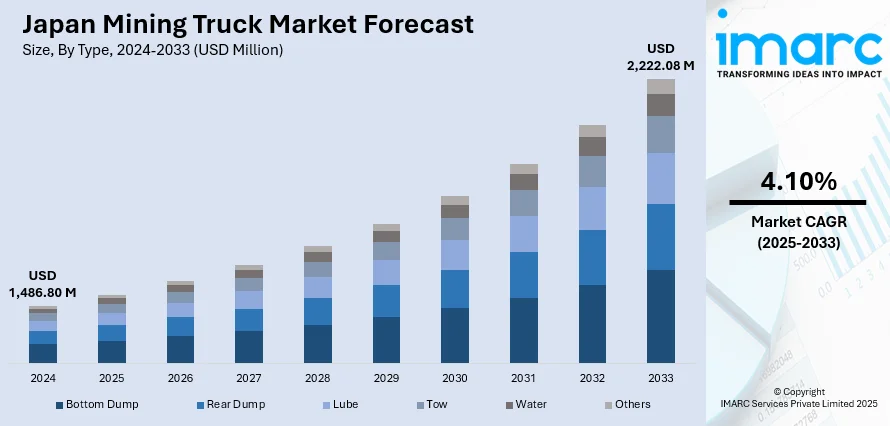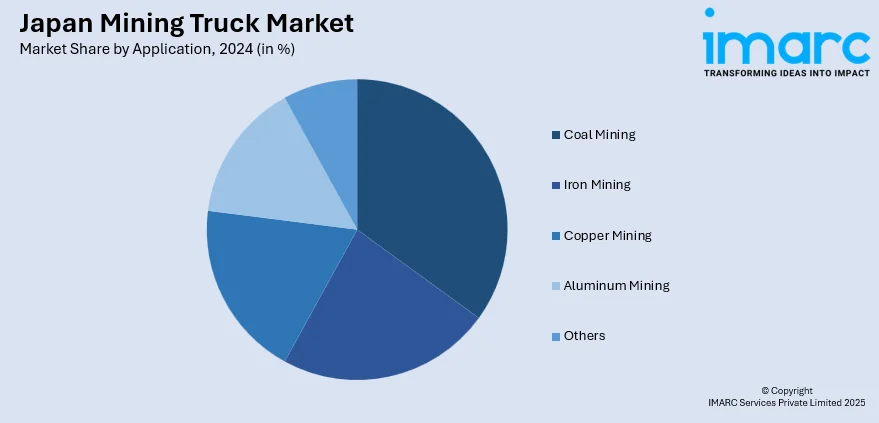
Japan Mining Truck Market Size, Share, Trends and Forecast by Type, Payload Capacity, Application, Drive, and Region, 2025-2033
Japan Mining Truck Market Overview:
The Japan mining truck market size reached USD 1,486.80 Million in 2024. Looking forward, IMARC Group expects the market to reach USD 2,222.08 Million by 2033, exhibiting a growth rate (CAGR) of 4.10% during 2025-2033. Japan's mining truck market is driven by the nation's push for automation and sustainability, elevating demand for high-performance trucks due to deeper mineral excavation, advancements in electric and autonomous vehicle technology, and supportive government policies aimed at reducing carbon emissions while enhancing industrial efficiency and productivity in the mining sector.
|
Report Attribute
|
Key Statistics
|
|---|---|
|
Base Year
|
2024 |
|
Forecast Years
|
2025-2033
|
|
Historical Years
|
2019-2024
|
| Market Size in 2024 | USD 1,486.80 Million |
| Market Forecast in 2033 | USD 2,222.08 Million |
| Market Growth Rate 2025-2033 | 4.10% |
Japan Mining Truck Market Trends:
Technological Advancements in Autonomous and Electric Mining Trucks
A key factor driving expansion in Japan's mining truck sector is the adoption of next-generation technologies, such as autonomous systems, for driving and electrification. Automated mining bolsters the efficiency of operations, safety, and sustainability credentials. Leading Japanese firms such as Komatsu are leading the development of autonomous haulage systems (AHS), which enable trucks to move autonomously, eliminating human errors, increasing precision in operations, and enhancing productivity in large-scale mining operations. Electric mining trucks are also experiencing increasing demand in Japan, propelled by the nation's decarbonization ambitions and efforts to minimize the carbon footprint of heavy industries. These electric trucks, which run on lithium-ion or hydrogen fuel cells, produce zero or much lower greenhouse gases than conventional diesel-fueled vehicles. Their usage not only enables mining companies to comply with more stringent environmental regulations but also lowers operational costs in the long run through reduced fuel and maintenance costs.

Depleting Domestic Mineral Resources and the Need for Deeper Excavations
With Japan's easily accessible mineral reserves dwindling, mining activities are being driven deeper, further, and into more geologically challenging areas. This change necessitates more powerful, stronger, and high-capacity mining trucks that can drive up steep slopes, haul heavier loads, and withstand tough terrain for extended periods. These underground mining operations tend to endure tough conditions that cannot be handled by regular trucks. Consequently, there has been a growing demand for specialized trucks with heavy-duty chassis, high-powered engines, sophisticated suspension systems, and higher capacity for carrying heavy loads. Furthermore, trucks with increased fuel efficiency and onboard diagnostic systems are essential in such risky, demanding environments to prevent expensive downtimes. Differing from surface mining, deep-earth mining encompasses greater logistics when it comes to material transport, which creates a demand for continuous-operation fleets of high-performance trucks.
Japan Mining Truck Market Segmentation:
IMARC Group provides an analysis of the key trends in each segment of the market, along with forecasts at the region/country level for 2025-2033. Our report has categorized the market based on type, payload capacity, application, and drive.
Type Insights:
- Bottom Dump
- Rear Dump
- Lube
- Tow
- Water
- Others
The report has provided a detailed breakup and analysis of the market based on the type. This includes bottom dump, rear dump, lube, tow, water, and others.
Payload Capacity Insights:
- <90 Metric Tons
- 90≤149 Metric Tons
- 150≤290 Metric Tons
- >290 Metric Tons
A detailed breakup and analysis of the market based on the payload capacity have also been provided in the report. This includes <90 metric tons, 90≤149 metric tons, 150≤290 metric tons, and >290 metric tons.
Application Insights:

- Coal Mining
- Iron Mining
- Copper Mining
- Aluminum Mining
- Others
The report has provided a detailed breakup and analysis of the market based on the application. This includes coal mining, iron mining, copper mining, aluminum mining, and others.
Drive Insights:
- Mechanical Drive
- Electrical Drive
A detailed breakup and analysis of the market based on the drive have also been provided in the report. This includes mechanical drive and electrical drive.
Regional Insights:
- Kanto Region
- Kansai/Kinki Region
- Central/Chubu Region
- Kyushu-Okinawa Region
- Tohoku Region
- Chugoku Region
- Hokkaido Region
- Shikoku Region
The report has also provided a comprehensive analysis of all the major regional markets, which include Kanto Region, Kansai/Kinki Region, Central/Chubu Region, Kyushu-Okinawa Region, Tohoku Region, Chugoku Region, Hokkaido Region, and Shikoku Region.
Competitive Landscape:
The market research report has also provided a comprehensive analysis of the competitive landscape. Competitive analysis such as market structure, key player positioning, top winning strategies, competitive dashboard, and company evaluation quadrant has been covered in the report. Also, detailed profiles of all major companies have been provided.
Japan Mining Truck Market News:
- February 2025: Bridgestone and Komatsu launched a proof of concept (PoC) to enhance mining truck operations by integrating Bridgestone’s iTrack tire monitoring system with Komatsu’s Komtrax Plus vehicle health platform. This collaboration aimed to improve fuel efficiency and extend tire life by analyzing real-time data on tire pressure, temperature, vehicle load, and haul road conditions.
- September 2024: Hitachi Construction Machinery introduced the EH4000AC-5 rigid dump truck, featuring 242-ton payload and enhanced durability through advanced metal fabrication technologies. This innovation addressed the demand for higher-capacity, efficient mining equipment, thereby influencing market dynamics. The truck's compatibility with electric specifications and improved operator comfort further aligned with industry trends towards sustainability and productivity.
- May 2023: Komatsu and Toyota partnered to enhance mining safety and efficiency by integrating Toyota's Autonomous Light Vehicles (ALVs) with Komatsu's Autonomous Haulage System (AHS). This collaboration aimed to reduce human error and improve productivity by enabling ALVs to operate seamlessly alongside Komatsu's autonomous haul trucks.
Japan Mining Truck Market Report Coverage:
| Report Features | Details |
|---|---|
| Base Year of the Analysis | 2024 |
| Historical Period | 2019-2024 |
| Forecast Period | 2025-2033 |
| Units | Million USD |
| Scope of the Report | Exploration of Historical Trends and Market Outlook, Industry Catalysts and Challenges, Segment-Wise Historical and Future Market Assessment:
|
| Types Covered | Bottom Dump, Rear Dump, Lube, Tow, Water, Others |
| Payload Capacities Covered | <90 Metric Tons, 90≤149 Metric Tons, 150≤290 Metric Tons, >290 Metric Tons |
| Applications Covered | Coal Mining, Iron Mining, Copper Mining, Aluminum Mining, Others |
| Drives Covered | Mechanical Drive, Electrical Drive |
| Regions Covered | Kanto Region, Kansai/Kinki Region, Central/Chubu Region, Kyushu-Okinawa Region, Tohoku Region, Chugoku Region, Hokkaido Region, Shikoku Region |
| Customization Scope | 10% Free Customization |
| Post-Sale Analyst Support | 10-12 Weeks |
| Delivery Format | PDF and Excel through Email (We can also provide the editable version of the report in PPT/Word format on special request) |
Key Questions Answered in This Report:
- How has the Japan mining truck market performed so far and how will it perform in the coming years?
- What is the breakup of the Japan mining truck market on the basis of type?
- What is the breakup of the Japan mining truck market on the basis of payload capacity?
- What is the breakup of the Japan mining truck market on the basis of application?
- What is the breakup of the Japan mining truck market on the basis of drive?
- What are the various stages in the value chain of the Japan mining truck market?
- What are the key driving factors and challenges in the Japan mining truck market?
- What is the structure of the Japan mining truck market and who are the key players?
- What is the degree of competition in the Japan mining truck market?
Key Benefits for Stakeholders:
- IMARC’s industry report offers a comprehensive quantitative analysis of various market segments, historical and current market trends, market forecasts, and dynamics of the Japan mining truck market from 2019-2033.
- The research report provides the latest information on the market drivers, challenges, and opportunities in the Japan mining truck market.
- Porter's five forces analysis assist stakeholders in assessing the impact of new entrants, competitive rivalry, supplier power, buyer power, and the threat of substitution. It helps stakeholders to analyze the level of competition within the Japan mining truck industry and its attractiveness.
- Competitive landscape allows stakeholders to understand their competitive environment and provides an insight into the current positions of key players in the market.
Need more help?
- Speak to our experienced analysts for insights on the current market scenarios.
- Include additional segments and countries to customize the report as per your requirement.
- Gain an unparalleled competitive advantage in your domain by understanding how to utilize the report and positively impacting your operations and revenue.
- For further assistance, please connect with our analysts.
 Request Customization
Request Customization
 Speak to an Analyst
Speak to an Analyst
 Request Brochure
Request Brochure
 Inquire Before Buying
Inquire Before Buying




.webp)




.webp)












